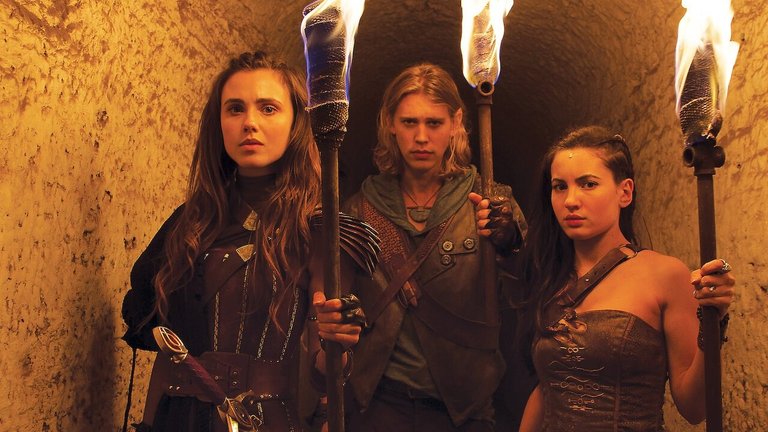Television Review: The Shannara Chronicles (Season 1, 2016)

The 2010s were the Golden Age of Television, but not so much for MTV. A television channel that for decades had been one of the pillars of global pop culture, exerting an immeasurably large (and not always positive) influence on other people’s film and television work, and dictating everything young people were supposed to love, has recently been forced to copy other people’s trends at the time. This is evident not only in how reality shows began to dominate its programming lineup instead of music videos, but also in its live-action shows lacking any particular originality. One such example is the TV series The Chronicles of Shannara.
The first season was based on The Elfstones of Shannara, a sprawling fantasy novel by Terry Brooks, which was the second part of his The Sword of Shannara trilogy. The story unfolds in the so-called Four Lands, a world that at first glance resembles a typical Tolkien-esque realm of elves, dwarves, trolls, gnomes, and wizards. Yet within it, one can occasionally stumble upon the ruins and other artefacts of a modern world that had apparently disappeared in a nuclear apocalypse thousands of years ago, after which survivors turned to magic instead of science. In the elven kingdom stands Ellcrys, a magical oak tree that begins to wither, opening a dimensional rift through which demons led by the dark wizard Dagda Mor (Jed Brophy) will surge into the world. Elf princess Amberle Elessedil (Poppy Drayton), a member of the order tasked with guarding Ellcrys, discovers that the tree can only be revived if a mysterious artefact hidden in the land of the trolls is found. On this perilous journey, she is accompanied by Will Ohmsford (Austin Butler), a young healer of mixed human-elf heritage who possesses “elfstones” that enable combat against demons, and Eretria (Ivana Baquero), a young woman raised among a band of roaming human scavengers.
Lack of originality has dogged Shannara since its first literary incarnation, namely the 1977 novel The Sword of Shannara, which critics lambasted for being overly inspired by Tolkien’s The Lord of the Rings. These comparisons, however, did not prevent Brooks’ book from becoming a bestseller and the foundation for an extraordinarily successful series that, until 2020, spanned 25 novels. Attempts to adapt Brooks’ world for big or small screens were numerous, though they were often hindered by the success of other projects—Peter Jackson’s Tolkien adaptations, Game of Thrones, and the general perception that the current television landscape was too small for three such major fantasy franchises. The Shannara Chronicles also suffered in comparisons with Legend of the Seeker, a 2008 fantasy series based on Terry Goodkind’s epic cycle, which shared much of Shannara’s setting, locations, ambition, and, ultimately, fate, being cancelled after two seasons.
Brooks’ world was adapted to television probably because MTV executives concluded that Shannara could benefit from other pop culture trends, particularly those tied to Game of Thrones or young adult dystopian sci-fi novels. The series is thus tailored primarily for a teenage audience, especially American. This is immediately evident in the characters speaking modern American English instead of British accents—rather unusual for fantasy fare—which, like certain Valley-speak phrases, will shatter immersion for some viewers. This is a far smaller issue than the noticeable budget constraints, which make epic battle scenes look far less spectacular than those in Game of Thrones, while exotic creatures resemble 1960s Star Trek humanoids. Comparisons with Game of Thrones suffered further by The Chronicles of Shannara adhering to a PG-13 rating: under MTV’s standards, explicit bloodshed and beheadings were permissible for teens, but no coarse language or nudity was allowed.
On the other hand, the first season of The Chronicles isn’t a complete waste of time for those who invest ten hours in it. The plot is adequately fleshed out (with a mini-cliffhanger left hanging for good measure), and the cast tries hard—particularly British newcomer Poppy Drayton and Spanish actress Ivana Baquero (famous for her role in Pan’s Labyrinth). Both of them handle American accents flawlessly, and their pairing with young Austin Butler creates a sufficiently engaging love triangle (with room for discreet lesbian undertones). New Zealand’s fantasy-ready locations are well exploited, and the country’s talent pool—home to actors known for Spartacus, including Manu Bennett, here impressively cast as the druid Allanon—adds depth. The standout, however, is the electronic score by Felix Erskine and Lucas Barton, which creates an indelible atmosphere and distinguishes the series enough from its far more famous and superior inspirations to spare viewers cringe-worthy déjà vu.
RATING: 5/10 (++)
(Note: The text in the original Croatian version is available here
Blog in Croatian https://draxblog.com
Blog in English https://draxreview.wordpress.com/
InLeo blog https://inleo.io/@drax.leo
LeoDex: https://leodex.io/?ref=drax
Hiveonboard: https://hiveonboard.com?ref=drax
InLeo: https://inleo.io/signup?referral=drax.leo
Rising Star game: https://www.risingstargame.com?referrer=drax
1Inch: https://1inch.exchange/#/r/0x83823d8CCB74F828148258BB4457642124b1328e
BTC donations: 1EWxiMiP6iiG9rger3NuUSd6HByaxQWafG
ETH donations: 0xB305F144323b99e6f8b1d66f5D7DE78B498C32A7
BCH donations: qpvxw0jax79lhmvlgcldkzpqanf03r9cjv8y6gtmk9
In spite of the criticisms, I loved the books. At least the first 3.
The show was not that great though. Not terrible, but just barely so.